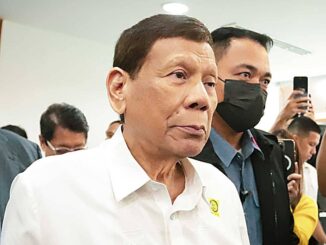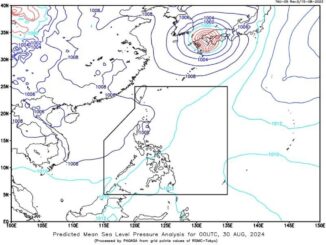
PRESIDENT Ferdinand Marcos Jr. approved the creation of a Cabinet cluster that will tackle the country’s crisis in education in “a whole system rather than in multi-agency silos,” Malacañang said Tuesday.
Palace press briefer Daphne Oseña-Paez said the President approved “in principle” the proposal during a sectoral meeting in Malacañang.
“This is to synthesize a common vision and common direction to reform the education system, to have positive long-term effect on every Filipino student and graduate,” Oseña-Paez said.
EDUCATION IN FOCUS President Ferdinand Marcos Jr. presides over a sectoral meeting on the Creation of Cabinet Cluster for Education on Aug. 13, 2024. PPA POOL PHOTO
She said the President recognized the urgency of creating the cluster “to address this learning crisis that has crippled our education system for decades,” which she noted resulted in a learning gap of 5.5 years for Filipino students.
“President Marcos directed the agencies to devise a coherent and system-wide national integrated education and workforce development strategy that starts from early childhood education to basic education, senior high school and so on,” the Palace official said.
“The President directed the proposed Cabinet cluster to ensure that education issues are tackled as a whole system rather than in multi-agency silos,” she added.
Education Secretary Juan Edgardo Angara, who joined the Palace press conference with Executive Director Karol Mark Yee of the Second Congressional Commission on Education (Edcom 2), thanked the President for his “swift action” on the proposal.
“Towards the end of the meeting, the President basically said that in principle, he approves of it, and he’d like us to fast-track some of the actions because he sees its urgency and it’s a very deep-seated problem,” Angara said.
“We need to follow through with the needs of every sector from early child development to daycare centers to kindergarten up to K-12, up to college, up to tech-voc, all of these, he said, should have positive interventions for our learners,” he added.
Angara said the cluster would be composed of the Department of Education (DepEd), the Commission on Higher Education (ChEd), the Technical Education and Skills Development Authority (Tesda), the Department of Labor and Employment, and the Department of Budget and Management.
He also said the cluster would not need additional funds because it was already in the existing budget.
The Edcom 2 earlier suggested the establishment of a Cabinet cluster for education under the Office of the President “to ensure a cohesive and coherent implementation of all laws, policies and reforms” on education across all government and non-government stakeholders.
In 2000, the National Coordinating Council for Education (NCCE) was formed almost a decade after Edcom 1 proposed its creation in a bid to “mitigate the risk of nonalignment” between the education sub-sectors composed of DepEd, CHEd and Tesda.

President Ferdinand Marcos Jr. presides over a sectoral meeting on the Creation of Cabinet Cluster for Education on August 13, 2024. PHOTO BY YUMMIE DINGDING / PPA POOL

President Ferdinand Marcos Jr. presides over a sectoral meeting on the Creation of Cabinet Cluster for Education on August 13, 2024. PHOTO BY YUMMIE DINGDING / PPA POOL

President Ferdinand Marcos Jr. presides over a sectoral meeting on the Creation of Cabinet Cluster for Education on August 13, 2024. PHOTO BY YUMMIE DINGDING / PPA POOL

President Ferdinand Marcos Jr. presides over a sectoral meeting on the Creation of Cabinet Cluster for Education on August 13, 2024. PHOTO BY YUMMIE DINGDING / PPA POOL

President Ferdinand Marcos Jr. presides over a sectoral meeting on the Creation of Cabinet Cluster for Education on August 13, 2024. PHOTO BY YUMMIE DINGDING / PPA POOL
However, the NCCE was abolished seven years later after failing to fulfill its goal.
The issues raised by Edcom 2 have long plagued the system, leading to “miseducation” or poorly delivered education to Filipino learners, which the commission acknowledged.
In the same briefing, Yee said that resolving the learning crisis remains the primary duty of DepEd but that “it is not something that it can achieve on its own” and underscored the need for other agencies to help.
“It’s really the national education and workforce development plan that is long-term that will anchor them all to make sure that there is one coherent direction, and that is what we proposed to the President — a Cabinet cluster that will come together, first and foremost, to formulate a 10-year integrated national education and workforce development plan,” Yee said.
“We are grateful to the President for really seeing this very quickly. He said we don’t have a system. We have different things happening, but not working together. We need to fix that. And we are very grateful for his leadership and putting his support behind this proposal, and his commitment to see this through,” he added.
Yee said that the Cabinet cluster’s work would be to “formulate a 10-year integrated national education and workforce development plan” and “make sure the agency targets and budgets are aligned to support this plan every year.”
A 2022 World Bank report on global learning poverty revealed that nine in 10 Filipinos could not read and understand a simple age-appropriate text at the age of 10.
The 2022 Program for International Student Assessment also showed that the Philippines remains among the world’s weakest in math, reading and science.
Just less than 25 percent of Filipino students who took the test in 2022 reached the minimum level of proficiency in math, reading and science. These scores indicated that the Philippines performed worse than the global average in all categories.
Necessity
House Basic Education and Culture Committee chairman and Pasig Rep. Roman Romulo lauded the creation of the Cabinet Cluster for Education, saying it would enhance the oversight and coordination of education-related agencies within the executive department.
The cluster would also address the learning crisis in the country with a unified approach.
The creation of the cluster follows a letter sent on July 11 by Edcom 2, chaired by Romulo and Baguio Rep. Marquez Go, urging the President to consider the proposal.
The chairmen and commissioners of the commission also filed a concurrent resolution that advocates the creation of the cluster.
In a statement, Romulo said the initiative is a “necessity,” citing the fragmented and disjointed efforts among various education agencies as an obstacle to progress.
“These efforts, while well-meaning, often result in further complications, leading to wasted resources and an overburdened workforce. This is a situation we can no longer afford to perpetuate,” Romulo said.
He added that a solution to a failing system should not be complicated but rather should be streamlined and should focus on core functions.
“When a system fails, the solution is not to add more layers of complexity. Instead, we must simplify, subtracting what is non-essential and focusing on building a strong, resilient foundation,” Romulo said.
With the creation of the Cabinet Cluster for Education, Romulo is hopeful that the change will ensure the consistent and effective delivery of quality education across all levels and bring long-term improvements to the education system.
He stressed that the move was not just a matter of governance but to ensure that every agency involved in education works in coordination, follows a clear policy direction and understands the urgency of the tasks at hand.
“By doing so, we will optimize the use of resources, eliminate redundancy and ensure that every effort contributes to the greater goal of providing quality education for all,” Romulo said.







Be the first to comment